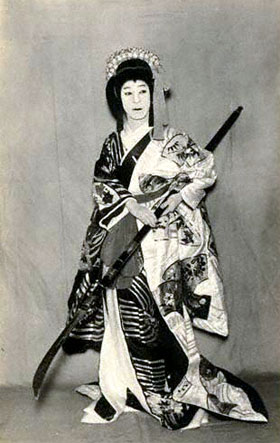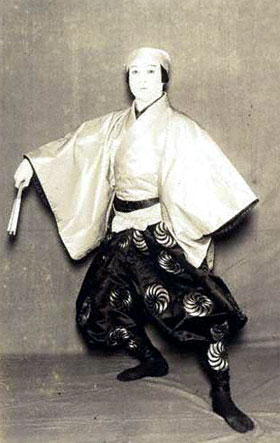| KURAMA JISHI |
| Dance titles | Meotozake Kawaranu Nakanaka Kurama Jishi Oshie no Hinagata |
| Common title | Kurama Jishi |
| Authors | Nakamura Jűsuke II (lyrics) Namizaki Tokuji (music) Nishikawa Senz˘ II (choreography) |
| History |
The Tomimoto-based dance-drama "Meotozake Kawaranu Nakanaka" was premiered in the 11th lunar month of 1777 at the Ichimuraza as a kaomise buy˘ for the kaomise drama "Chigo Torii Tobiiri Kitsune" [casting]. It was revived as a Kiyomoto-based dance-drama in the 11th lunar month of 1836 at the Moritaza. It was entitled "Kurama Jishi Oshie no Hinagata" and it was staged within in the kaomise drama "Kioi Genji Mitsugi no Tamamono" [more details]. It went into oblivion but was revived in 1912. It is now commonly called "Kurama Jishi" and is staged with a Kiyomoto musical ensemble. It became an important dance-drama for the Shigayama School of Buy˘. |
| Key words |
Daikagura Ise Jingű Kagura Kaomise Buy˘ Kawagoe Shigeyori Kerai Kiyomoto Kudoki Kurama Ky˘-no-Kimi Ky˘ran Ky˘ranmono Mimosusogawa Minamoto Yoshitsune Naginata Seishitsu Shigayama-ryű Shishi Shishimai Shosagoto Tomimoto |
| Summary |
Hearing of the death of her husband Minamoto no Yoshitsune, Ky˘-no-Kimi has gone out of her mind from grief. She is desperately roving the countryside, weeping and seeking her lost husband. She carries with her a naginata, which had belonged to her father Kawagoe Tar˘ Shigeyori. As she wanders near Mimosuso River at Ise, a performer of the Daikagura dance happens to pass by. He is in reality Yoshioka no Kisanta, a former retainer (kerai) of Yoshitsune, in disguise. The dance skillfully contrasts the beauty of a lovely mad lady and the humorous nature of the Kagura dancer. The lady's major dances are the one on the hanamichi in which she is seen seeking her lost husband (kudoki), and the mad dance in which she gives voice to her love lament, imagining a meeting with Yoshitsune. Kisanta's major dances are the Kagura dance describing the legend of the Ise Shrine, followed by the shishimai dance using the traditional hand-held shishi head. During the dance Ky˘-no-Kimi snatches from him his prayer bell. She uses it frantically, hoping to attract Yoshitsune's attention. When Kisanta tries to get it back, he is threatened by Ky˘-no-Kimi and her naginata. Kisanta continues his dance, frightened by the mad and wild looks of Ky˘-no-Kimi. Then, he tries to escape but he is followed by Ky˘-no-Kimi, who has dropped her naginata behing her. He tells her to go to pick it up and, while she's doing it, he suddenly disappears. Ky˘-no-Kimi has already forgotten everything and, with her naginata, she pursues her aimless wandering in the countryside. |
| Trivia |
The original dance was about Shizuka Gozen, the mistress of Minamoto no Yoshitsune. The main female role later switched to Yoshitsune's seishitsu Ky˘-no-Kimi. The dance is not set on Mount Kurama or in the village of Kurama but there is several allusion to Kurama during Ky˘-no-Kimi's dance. |
 |
 |
|
Sawamura S˘nosuke I playing the role of Ky˘-no-Kimi in the dance-drama "Kurama Jishi", which was staged in September 1922 at the Ichimuraza |
Band˘ Mitsugor˘ VII playing the role of Yoshioka no Kisanta in the dance-drama "Kurama Jishi", which was staged in November 1929 at the Meijiza |
|
|
| Contact | Main | Top | Updates | Actors | Plays | Playwrights | Programs | Links | FAQ | Glossary | Chronology | Illustrations | Prints | Characters | Derivatives | Theaters | Coming soon | News |